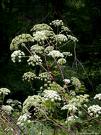What is Angelica sinensis | Archangel | angelica | archangel raphaelAngelica plant is an excellent stimulant and overall tonic for good health. Angelica has been called the Angel Herb. The name Angelica archangelica is believed to have been given by a monk in the mid-17th century, who had a dream in which Archangel Raphael appeared and pronounced the herb to be a cure for the plague. Uses of angelica include treatment of common digestive problems such as indigestion, flatulence, stomach pains and intestinal spasms. The most widespread medicine is the product of Angelica sinensis root and many people use Angelica daily to maintain good health condition. 
Angelica archangelica Apiaceae Also called Archangel. Known in the past as the Root of the Holy Spirit, angelica is a striking architectural plant whose thick, hollow stalks can grow to 3m tall. It has finely cut leaves and its oval fruits have wings like those if an angel, hence its name. In the Renaissance, angelica was thought to be able to cure all illnesses. ConstituentsAngelica root is made up of 1 per cent essential oil. This consists mainly of beta-phellandrene, along with the aromatic coumarins angelicin, bergapten and osthole. Medicinal usesAngelica root is mainly used to treat common digestive problems such as indigestion and flatulence. It is also recommended for stomach pains and intestinal spasms. Angelica has long been used as a remedy for coughs, colds and influenza because it acts as an expectorant. It is particularly recommended for bronchitis. A root extract may alleviate the painful symptoms of back pain, gout and rheumatism: in 1978, researchers demonstrated angelica's antiinflammatory and pain-relieving properties. The root oil is also antibacterial and antifungal. In 1996 researchers found osthole to be an effective anticoagulant, and thus potentially useful for treating thrombosis. And in 1998, researchers described bergapten as a photosensitising agent that could benefit psoriasis sufferers. Angelica can be taken as a bitter tonic. It works by increasing appetite through stimulation of the salivary glands and digestive organs. Parts usedRoots The hard roots are collected from one to two-year-old plants. Roots are washed, cut up and dried in the open air. They are used in decoctions, in capsules or in a drinkable solution. PREPARATION AND DOSAGEFor Internal Use TO TREAT digestive problems, colds and coughs, fatigue INFUSION Put 1-2g dried root in 1 cup of boiling water. Strain and drink three times a day. DECOCTION Put 1 teaspoon of root into % cup of water, bring to the boil and steep for 5 minutes. Strain. Take as two doses during the day. LIQUID EXTRACT (1:1 in 25% alcohol) Take 0.5-2ml root extract, three times a day. TINCTURE (1:5 in 50% alcohol) Take 0.5-2ml three times a day. IF SYMPTOMS PERSIST CONSULT A DOCTOR CultivationAngelica is easily grown from seed. It is a hardy plant suited to moist soils and temperate climates. It is happy in sun or light shade. CAUTIONS
|
Ayurveda Book
This book on Ayurveda is meant for people interested to know about basics concepts of Ayurvedic healing and learn ayurveda concepts. Though there are many books Read More My SitesReal Testimonials
Connect with us |







